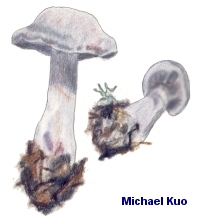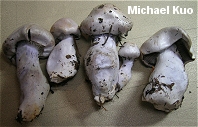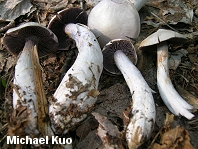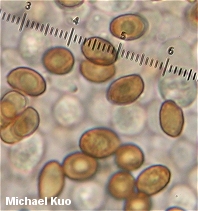| Major Groups > Gilled Mushrooms > Dark-Spored > Cortinarius > Cortinarius alboviolaceus |

|
Cortinarius alboviolaceus [Basidiomycetes > Agaricales > Cortinariaceae > Cortinarius ... ] by Michael Kuo Cortinarius alboviolaceus was first described in 1801 by Persoon, who said it was a common mushroom in European forests, characterized by its pale, bell-shaped cap, its pale purple gills, and its club-shaped stem. By its contemporary European definition it is partial to birch, and manifests not only the features emphasized by Persoon, but also a stem base that is "booted" with veil material, very slightly warty spores, and a lack of a distinctive odor. I have collected the species in Finland (see the top illustration), where it is fairly distinct and easily identified--unless, of course, there are cryptic phylogenetic species hiding out in the concept of Cortinarius alboviolaceus, as researchers discovered was the case for Cortinarius armillatus. Do we have Cortinarius alboviolaceus in North America? The species appears in a host of North American field guides (see the list of references below) spanning the continent from California to Texas, Kansas, Michigan, and the northeast . . . which is probably a big clue that what we actually have is a group of alboviolaceus-like species in need of contemporary study. Description: Ecology: Mycorrhizal with hardwoods, especially birch; growing alone or gregariously; summer and fall; widely distributed in North America, as a species group (see comments above). Cap: 3-7 cm; convex to bell-shaped, becoming broadly bell-shaped or flat, with a broad central bump; dry; satiny; pale purplish at first, but covered with whitish veil material, becoming silvery or whitish lilac. Gills: Attached to the stem; close; pale purplish at first, becoming cinnamon to rusty brown; covered by a white cortina when young. Stem: 5-9 cm long; up to about 1 cm thick at the apex; usually swollen at the base or club-shaped; dry; silky; pale lilac, especially near the apex; with whitish to silvery fibers that may trap mature spores and thus develop rusty colors; basally "booted" or sheathed with white veil material. Flesh: Whitish or pale lilac. Odor: Not distinctive, or very faintly radishlike. Chemical Reactions: KOH negative on cap surface. Spore Print: Rusty brown. Microscopic Features: Spores 7.5-9. 5 x 5-6 µ; ellipsoid; very slightly roughened (appearing almost smooth). Pleuro- and cheilocystidia absent. Pileipellis a cutis. REFERENCES: (Persoon, 1801) Fries, 1838. (Fries, 1821; Saccardo, 1887; Kauffman, 1918; Kauffman, 1932; Moser, 1983; Arora, 1986; Phillips, 1991/2005; Hansen & Knudsen, 1992; Lincoff, 1992; Metzler & Metzler, 1992; Horn, Kay & Abel, 1992; Barron, 1999; Breitenbach & Kränzlin, 2000; McNeil, 2006; Miller & Miller, 2006; Binion et al., 2008; Trudell & Ammirati, 2009.) Herb. Kuo 09120509. Herb DBG RMNP 2008-113. This site contains no information about the edibility or toxicity of mushrooms. |
© MushroomExpert.Com |
|
Cite this page as: Kuo, M. (2011, December). Cortinarius alboviolaceus. Retrieved from the MushroomExpert.Com Web site: http://www.mushroomexpert.com/cortinarius_alboviolaceus.html |



